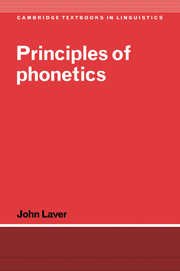Book contents
- Frontmatter
- Contents
- List of figures
- List of tables
- Preface
- Acknowledgements
- Introduction
- PART I General concepts
- PART II The analytic framework
- PART III Initiation and phonation
- PART IV Linear segmental analysis
- 8 Stop articulations
- 9 Fricative articulations
- 10 Resonant articulations
- 11 Multiple articulations
- PART V Articulatory co-ordination and phonetic settings
- PART VI Temporal, prosodic and metrical analysis
- PART VII Principles of transcription
- PART VIII Conclusion
- Envoi
- Appendix I The phonetic alphabet of the International Phonetic Association
- Appendix II Index of languages
- References
- Index of names
- Subject index
10 - Resonant articulations
Published online by Cambridge University Press: 05 June 2012
- Frontmatter
- Contents
- List of figures
- List of tables
- Preface
- Acknowledgements
- Introduction
- PART I General concepts
- PART II The analytic framework
- PART III Initiation and phonation
- PART IV Linear segmental analysis
- 8 Stop articulations
- 9 Fricative articulations
- 10 Resonant articulations
- 11 Multiple articulations
- PART V Articulatory co-ordination and phonetic settings
- PART VI Temporal, prosodic and metrical analysis
- PART VII Principles of transcription
- PART VIII Conclusion
- Envoi
- Appendix I The phonetic alphabet of the International Phonetic Association
- Appendix II Index of languages
- References
- Index of names
- Subject index
Summary
All resonants have a stricture of open approximation. A necessary condition for the performance of resonants is that the airstream passes through the vocal tract in a smoothly laminar flow, with no audible local friction. Resonants were said in chapter 5 to be classifiable into central resonants and lateral resonants. This chapter will begin by describing the production of central resonants. The description of lateral resonants is presented later, in section 10.13.
Resonants which are central are classified as non-contoid segments. When non-contoids are marginal in the syllable, the label attached to them in the descriptive model offered in this book is that of non-syllabic approximants (or approximants, for brevity). When non-contoids are nuclear in the syllable – that is, when they are syllabic, they are classified as syllabic vocoids (or vocoids, for brevity). Figure 10.1 shows these relationships, replicating part of figure 5.18 for convenience. Approximants by definition always function phonologically as consonants. Vocoids by definition always function phonologically as vowels. In these senses, the pronunciation [j] corresponding to the letter ‘y’ in the English word yes [j∈s] is an approximant, and that to the ‘e’ is a vocoid. Similarly, the pronunciation corresponding to the letter ‘w’ in the English word wit [wIt] is an approximant, and that to the ‘i’ is a vocoid.
The term ‘approximant’, which was invented by Ladefoged (1964), is in the usage of this book broadly comparable to the traditional phonetic terms ‘semi-vowel’ and ‘frictionless continuant’ (though the category of ‘frictionless continuants’ is sometimes taken to include the concept of lateral resonants).
- Type
- Chapter
- Information
- Principles of Phonetics , pp. 269 - 313Publisher: Cambridge University PressPrint publication year: 1994



